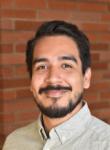Sandoval, Rafael

Rafael is a PhD student in the Biochemistry, Biophysics, & Structural Biology (BBSB) home area of the MBIDP, where he works in the laboratory of Dr. Jesse R. Zamudio. He received a B.S. in Biochemistry and Cell Biology at the University of California, San Diego (UCSD) and an M.S. at California State University, Los Angeles (CSULA). He joined the CMB training program in 2020.
Mentor: Dr. Jesse Zamudio
Pericentromeric heterochromatin (PCH) plays essential structural roles in mitotic chromosome segregation and functions to repress the transcription of underlying DNA repeats. Perturbing this heterochromatin state leads to abnormal chromosome segregation, while accumulation of aberrantly expressed pericentromeric ncRNA leads to chromosome instability and ultimately tumorigenesis in mouse models. In many eukaryotes, RNA interference (RNAi) machinery regulates the heterochromatin state and transcriptional output of the pericentromere. The RNAi-mediated epigenetic regulation of the pericentromere is well resolved in Schizosaccharomyces pombe (S. pombe) and Arabidopsis thaliana (A. thaliana) but remains obscure in mammals. However, mounting evidence suggests an RNA component is necessary for maintaining mammalian heterochromatin integrity. Understanding the mechanisms that underlie epigenetic regulation of the pericentromere in mammals will elucidate potential novel mechanisms of cancer progression.
My project’s goal is to determine the potential role Argonaute2 plays in the heterochromatin assembly and transcriptional regulation of the pericentromere in mice. I will employ a variety of molecular tools to resolve this inquiry. Namely, I will utilize a mouse embryonic stem cell (mESC) system that has an Ago1-4 null background and a doxycycline inducible Ago2, thus affording me precise, reversible, and tight control over Ago2 expression. I will leverage northern blot analysis to characterize pericentromeric ncRNA in Ago2 wild-type and knockout conditions to assess changes in RNA abundance and size heterogeneity. In addition, I will use an in-house developed small RNA cloning method to interrogate changes in major satellite siRNA profiles in varying levels of Ago2 expression.


